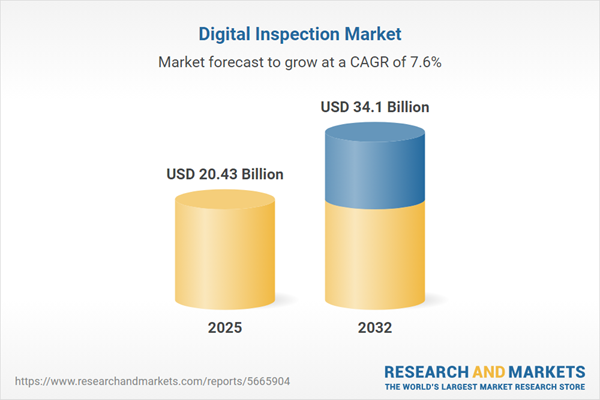Speak directly to the analyst to clarify any post sales queries you may have.
Digital inspection solutions are transforming asset-intensive industries by enabling leaders to modernize operations, enhance quality standards, and address regulatory requirements. These systems empower senior executives to make data-driven decisions, increasing reliability and operational agility across diverse sectors.
Market Snapshot: Digital Inspection Market Growth Dynamics
The digital inspection market stands at USD 18.95 billion and is projected to reach USD 20.43 billion within the next year. Forecasts indicate the market could achieve USD 34.10 billion by 2032, sustained by a compound annual growth rate (CAGR) of 7.61%. Key market drivers include broader adoption of advanced sensing technologies, expanding roles for artificial intelligence in inspection workflows, and a strategic shift toward cloud-centric architectures. Leading organizations in manufacturing, oil and gas, and the energy sector are leveraging digital inspection solutions to enhance adaptability, technical capability, and compliance in response to evolving customer and regulatory demands.
Scope & Segmentation of the Digital Inspection Market
Understanding the structure of the digital inspection market enables decision-makers to align modernization goals, drive process efficiency, and mitigate operational risks. The following segmentation illustrates the breadth of use cases and solution offerings across industries.
- End-Use Industries: Aerospace prioritizes safety and compliance systems. Automotive benefits from advanced diagnostic and maintenance solutions. Manufacturing industries, including electronics and heavy sectors, focus on quality assurance. Oil and gas emphasizes secure extraction and transportation procedures. Energy, both conventional and renewable, implements digital inspection tools for extensive facility oversight.
- Component Types: Hardware encompasses ruggedized sensors and mobile scanning devices. Software solutions provide analytics, diagnostics, and process automation. Service partners offer integration, ongoing technical maintenance, and digital transformation guidance.
- Technology Solutions: Eddy current systems detect material inconsistencies. Sensor-based instruments streamline asset assessments. Laser scanners support precise, non-contact measurement. Magnetic particle tools inspect for structural integrity. Ultrasonic technologies are used for subsurface flaw identification. Automated visual inspection systems combine machine learning with human expertise for better decision-making.
- Deployment Modes: Cloud-based options facilitate remote access and enable centralized monitoring. Hybrid deployments make it possible to connect new digital platforms with legacy infrastructure. On-premise approaches support organizations requiring dedicated, secure environments.
- Regional Presence: The Americas drive innovation and early adoption. EMEA maintains a strong focus on regulatory compliance and industry standards. Asia-Pacific represents a high-growth region, particularly in China, India, Japan, South Korea, and Southeast Asia. South America demonstrates ongoing progress as adoption diversifies.
- Leading Companies: Keyence Corporation, Cognex Corporation, Omron Corporation, Teledyne Technologies Incorporated, Basler AG, SICK Aktiengesellschaft, Hexagon AB, Olympus Corporation, Nikon Corporation, and FARO Technologies, Inc. each provide scalable, sector-tailored solutions on a global scale.
Key Takeaways for Senior Decision-Makers
- Digital inspection platforms enhance compliance and improve system reliability, helping organizations address both product and operational challenges in varied environments.
- Cloud and hybrid technologies break information silos, supporting the modernization of asset monitoring and decision-support processes.
- Customizable diagnostic and monitoring tools enable real-time responses to changing onsite demands or unexpected field conditions.
- Implementation of digital twin concepts and advanced analytics fosters predictive maintenance and continuous operational optimization by reducing unplanned disruptions.
- Strategic alliances with system integrators and established technology providers offer scalability and flexibility as digital inspection requirements evolve.
- Integrating digital inspection across multiple locations supports unified quality frameworks and standardizes compliance management throughout the enterprise.
Tariff Impact: U.S. Policy and Procurement Strategy
Recent U.S. tariff adjustments have increased procurement costs for digital inspection platforms and related technology assets. To navigate these changes, organizations are broadening their supplier networks and adapting procurement strategies. Companies increasingly favor modular, software-led approaches to enhance organizational agility in response to regulatory and financial pressures.
Methodology & Data Sources
This market analysis draws from leading industry publications, patent repositories, regulatory agency data, stakeholder surveys, and expert interviews. This blended approach provides a comprehensive perspective on both reliable growth drivers and emerging market risks.
Why This Report Matters
- Enables executive leaders to align digital inspection investments with business goals, operational priorities, and risk management frameworks.
- Strengthens procurement procedures and control systems, supporting organizational resilience as regulatory and market environments evolve.
- Delivers actionable guidance to accelerate digital transformation, improve efficiency, and drive long-term business growth initiatives.
Conclusion
Digital inspection technologies are advancing quality assurance and operational safety across asset-driven sectors. Executives investing in these solutions are equipped to establish strong, flexible leadership as industry and compliance demands evolve.
Additional Product Information:
- Purchase of this report includes 1 year online access with quarterly updates.
- This report can be updated on request. Please contact our Customer Experience team using the Ask a Question widget on our website.
Table of Contents
3. Executive Summary
4. Market Overview
7. Cumulative Impact of Artificial Intelligence 2025
Companies Mentioned
The companies profiled in this Digital Inspection market report include:- Keyence Corporation
- Cognex Corporation
- Omron Corporation
- Teledyne Technologies Incorporated
- Basler AG
- SICK Aktiengesellschaft
- Hexagon AB
- Olympus Corporation
- Nikon Corporation
- FARO Technologies, Inc.
Table Information
| Report Attribute | Details |
|---|---|
| No. of Pages | 191 |
| Published | October 2025 |
| Forecast Period | 2025 - 2032 |
| Estimated Market Value ( USD | $ 20.43 Billion |
| Forecasted Market Value ( USD | $ 34.1 Billion |
| Compound Annual Growth Rate | 7.6% |
| Regions Covered | Global |
| No. of Companies Mentioned | 11 |









